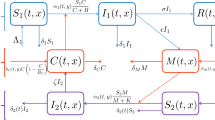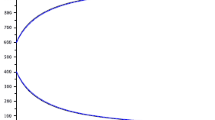Abstract
We formulate and analyze a system of ordinary differential equations for the transmission of schistosomiasis japonica on the islets in the Yangtze River, China. The impact of growing islets on the spread of schistosomiasis is investigated by the bifurcation analysis. Using the projection technique developed by Hassard, Kazarinoff and Wan, the normal form of the cusp bifurcation of codimension 2 is derived to overcome the technical difficulties in studying the existence, stability, and bifurcation of the multiple endemic equilibria in high-dimensional phase space. We show that the model can also undergo transcritical bifurcations, saddle-node bifurcations, a pitchfork bifurcation, and Hopf bifurcations. The bifurcation diagrams and epidemiological interpretations are given. We conclude that when the islet reaches a critical size, the transmission cycle of the schistosomiasis japonica between wild rats Rattus norvegicus and snails Oncomelania hupensis could be established, which serves as a possible source of schistosomiasis transmission along the Yangtze River.





Similar content being viewed by others
References
Anderson RM, May RM (1991) Infectious diseases of humans: dynamics and control. Oxford University Press, New York
Carr L (1981) Applications of centre manifold theory. Springer, New York-Berlin
Castillo-Chavez C, Feng Z, Xu D (2008) A schistosomiasis model with mating structure and time delay. Math Biosci 211:333–341
Chow S-N, Li C, Wang D (1994) Normal forms and bifurcation of planar vector fields. Cambridge University Press, Cambridge
Feng Z, Li C-C, Milner FA (2002) Schistosomiasis models with density dependence and age of infection in snail dynamics. Math Biosci 177/178:271–286
Feng Z, Li C-C, Milner FA (2005) Schistosomiasis models with two migrating human groups. Math Comput Model 41:1213–1230
Hassard BD, Kazarinoff ND, Wan Y-H (1981) Theory and applications of Hopf bifurcation. Cambridge University Press, Cambridge-New York
Gryseels B, Polman Katja, Jan Clerinx, Kestens Luc (2006) Human schistosomiasis. Lancet 368:1106–1118
Guo Y (1991) Snail biology, schistosome biology, prevention and cure of schistosomiasis. People Health Press, Beijing
Liang S, Maszle D, Spear RC (2002) A quantitative framework for a multi-group model of Schistosomiasis japonicum transmission dynamics and control in Sichuan, China. Acta Trop 82:263–277
Liang S et al (2007) Environmental effects on parasitic disease transmission exemplified by schistosomiasis in western China. PNAS 104:7110–7115
Kuznetsov Yuri A (1998) Elements of applied bifurcation theory. Springer, New York
MacDonald G (1965) The dynamics of helminth infections with spatial reference to schistosomes. Trans R Soc Trop Med Hyg 59:489–506
Nåsell I, Hirsch WM (1973) The transmission dynamics of schistosomiasis. Commun Pure Appl Math 26:395–453
Poggensee G, Feldmeier H (2001) Female genital schistosomiasis: facts and hypotheses. Acta Trop 79:193–210
Poggensee G, Feldmeier H, Krantz I (1999) Schistosomiasis of the female genital tract: public health aspects. Parasitol Today 15:378–381
Spear RC, Hubbard A, Liang S, Seto E (2002) Disease transmission models for public health decision making: toward an approach for designing intervention strategies for Schistosomiasis japonica. Environ Health Perspect 110:907–915
van den Driessche P, Watmough J (2002) Reproduction numbers and sub-threshold endemic equilibria for compartmental models of disease transmission. Math Biosci 180:29–48
Wu J, Liu N, Zuo S (1987) The qualitative analysis of model of the transmission dynamics of Japanese schistosomiasis. Appl Math A 2:352–362
Wu J, Feng Z (2002) Mathematical models for schistosomiasis with delays and multiple definitive host, mathematical approaches for emerging and reemerging infectious disease: models, methods, and theory (Minneapolis, MN, 1999), 215–229, IMA Vol. Math Appl, 126, Springer, New York
Xu G, Tian J, Chen G, Yang H, Qiu L, Hu H, Xie C, Zhou W, Yin W, Zhao Y, Cai G, Pang H, Wu W (1999) Observation of natural focal disease of schistosomiasis in Rattus norvegicus in Nanjing. J Pract Parasitol 7:4–6 (in Chinese)
Zhang P, Feng Z, Milner FA (2007) A schistosomiasis model with an age-structure in human hosts and its application to treatment strategies. Math Biosci 205:83–107
Zhao G, Zhao Q, Jiang Q, Chen X, Wang L, Yuan H (2005) Surveillance for Schistosomiasis japonica in China from 2000 to 2003. Acta Trop 96:288–295
Zhao R, Milner FA (2008) A mathematical model of Schistosoma mansoni in Biomphalaria glabrata with control strategies. Bull Math Biol 70:1886–1905
Zhou X (2005) Science on oncomelania snail. Science Press, Beijing
Zhou X, Lin D, Yang H, Chen H, Sun L, Yang G, Hong Q, Brown L, Malone J (2002) Use of Landsat TM satellite surveillance data to measure the impact of the 1998 flood on snail intermediate host dispersal in the lower Yangtze River basin. Acta Trop 82:199–205
Zhou X, Wang L, Chen M, Wu X, Jiang Q, Chen X, Zheng J, Jury U (2005) The public health significance and control of schistosomiasis in China-then and now. Acta Trop 96:96–105
Acknowledgments
This research was supported by NSERC and ERA, an Early Researcher Award of Ministry of Research and Innovation of Ontario, Canada and NSFC-11171267 of China.
Author information
Authors and Affiliations
Corresponding author
Rights and permissions
About this article
Cite this article
Shan, C., Zhou, X. & Zhu, H. The Dynamics of Growing Islets and Transmission of Schistosomiasis Japonica in the Yangtze River. Bull Math Biol 76, 1194–1217 (2014). https://doi.org/10.1007/s11538-014-9961-7
Received:
Accepted:
Published:
Issue Date:
DOI: https://doi.org/10.1007/s11538-014-9961-7




